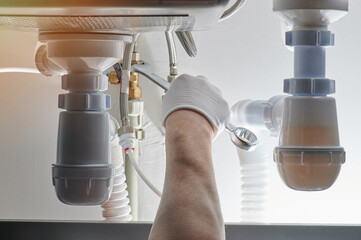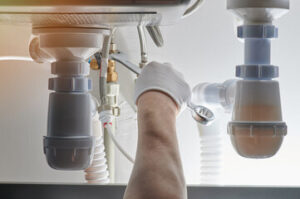
The Work of a Plumber
Plumbers install, maintain, and repair pipes and systems that transport water, gas, sewage, and other fluids. Plumbers also install fixtures and appliances such as sinks, toilets and bathtubs. Plumbers typically work full-time and must be available to respond to emergencies. Often they travel to different job sites each day.
 Plumbers assemble, repair and maintain pipes and systems that carry water and gas to and from homes and businesses. They also inspect and test plumbing to ensure it is in good working order. They may also install faucets, toilets and bathtubs. A typical job description for plumbers might include meeting with customers to complete work orders, responding to emergency calls and performing preventative maintenance.
Plumbers assemble, repair and maintain pipes and systems that carry water and gas to and from homes and businesses. They also inspect and test plumbing to ensure it is in good working order. They may also install faucets, toilets and bathtubs. A typical job description for plumbers might include meeting with customers to complete work orders, responding to emergency calls and performing preventative maintenance.
Moreover, they often handle drainage and sewer issues, repairing or replacing broken lines or fixtures. This is not a sexy or glamorous profession, but it’s one that requires exceptional problem-solving skills and mechanical aptitude to succeed. Plumbers are also required to exercise regularly, as they bend, crouch and squeeze into tight spaces to reach difficult spots. They need to be strong enough to haul heavy pipes and equipment around all day.
Education and Training Requirements. Plumbing jobs remain in high demand and are among the most lucrative in the construction industry. Young people interested in this trade have several options for entering the industry. Most plumbers complete apprenticeship training that lasts from four to five years. The training is often sponsored by unions and trade associations and consists of classroom and on-the-job instruction.
During an apprenticeship, you learn safety, local plumbing codes, blueprint reading and piping systems. You also study mathematics, physics and chemistry. You should have a high school diploma or GED equivalent before you begin your education. You can also obtain a certificate or degree from a technical school or community college.
In New York, journeyman plumbers need to be registered and document proof of at least five years of experience before they are allowed to take the exam for a Certificate of Competency. Apprentice plumbers must be registered and work under the supervision of a licensed master plumber.
Plumbers install and repair pipes that transport liquids, gases and waste from homes, businesses and factories. These pipes move water for drinking and sanitation, chemicals for product manufacturing, and steam for electricity generation. Most workers in this occupation are employed by construction companies, plumbing contractors or maintenance departments, though they may also be self-employed. Many work long hours, including nights and weekends.
Master plumbers working on construction projects help design blueprints for all pipes and fixtures to ensure that structures meet building codes, stay within a budget and work well with other features, such as electric wires. This requires an understanding of blueprints, a detailed knowledge of plumbing systems and an ability to visualize the entire structure from drawings.
Physically demanding tasks, such as operating tools and lifting heavy objects, can lead to injury. Loud noises, such as from hammers and pipe banging, can also cause hearing loss. Additionally, working in closed spaces that are not designed for oxygen levels can lead to severe health conditions, including breathing problems and heart attacks.
Plumbers are responsible for the installation and maintenance of water systems in buildings. These include drinking water, heating, drainage, and sewage systems. Plumber salaries vary depending on their experience level, certifications, and location. Apprentices are paid the lowest, while journeymen and master plumbers earn higher salaries.
The average salary for a plumber ranges from $45 per hour to $200. This figure was calculated by averaging the low and high end of pay for all plumbing positions across the United States.
Plumbers are highly regulated in most of the United States, and it is common for them to receive training and education on the job through an apprenticeship program. After completing an apprenticeship, they may take certification exams to become licensed. These exams can help them increase their overall earning potential. Those who have certifications can also negotiate for better pay. This is because they will have an established track record and a commitment to their career goals.
